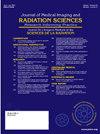Thinking Outside the Brachytherapy Suite: A Novel Radiation Therapist-led Approach for Gold Seed Insertions
IF 1.3
Q3 RADIOLOGY, NUCLEAR MEDICINE & MEDICAL IMAGING
Journal of Medical Imaging and Radiation Sciences
Pub Date : 2025-05-01
DOI:10.1016/j.jmir.2025.101955
引用次数: 0
Abstract
Purpose/Aim
There are 400 patients treated with prostate stereotactic body radiation therapy (SBRT) at our institution annually. To facilitate image guidance, patients require insertion of three gold seeds (GS) prior to simulation, which is a stress on departmental resources given patient volumes. GS are implanted by a Radiation Oncologist in our brachytherapy (BT) suite under local anaesthesia, using trans-rectal ultrasound guidance through the perineum, during limited non-anaesthesia time. Nursing (RN) assumes responsibility for patient teaching, vital signs, and procedural monitoring, while Radiation Therapists (RTTs) are responsible for sterile field and ultrasound preparation, equipment troubleshooting, and patient positioning. Here, we describe a novel and lean RTT-led workflow implemented at our centre for GS insertions for prostate SBRT.
Methods/Process
Opportunities for improvement in the existing GS workflow, identified through a mapping exercise, included procedure location, patient education, and task-sharing amongst the interprofessional team. Given limited non-anaesthesia time within our BT suite, our sporadically used orthovoltage bunker was selected as an alternate location and equipped for procedures, with a room layout designed by RTTs to facilitate GS insertion. Updated patient education handouts, encompassing pre- and post-procedure instructions, were developed by RTTs and RNs in conjunction with patient and family education. New patient teaching guidelines were formalized to allow RTTs to assume responsibility. A protocol for RTT-led pre-procedural time-outs was implemented, adapted with RN input from surgical time-outs used for general anaesthesia cases. RTTs were trained in procedural monitoring, covering pre-procedural concerns such as anti-coagulation, indications for vital signs monitoring, and recognizing signs and symptoms of local anaesthetic systemic toxicity, supported by a process map for managing adverse events including guidelines for re-engaging RN support. Surgical documentation was modified in collaboration with RNs for use by RTTs from pre-procedural teaching to patient discharge. RTT-led GS insertions were implemented iteratively, with regular evaluation by the interprofessional team to identify any potential gaps in knowledge and sequential adjustment of the workflow, ensuring continuous quality of patient care.
Results or Benefits/Challenges
GS insertions in our orthovoltage bunker can be completed in parallel to procedures in our BT suite, representing significant resource optimization and potential for expansion of our BT program. Our novel workflow represents significant role expansion for RTTs, who now provide continuous care to patients throughout the GS insertion process. Organization of the orthovoltage bunker for use as a procedure room required numerous iterations to achieve optimal functionality. Perceived scope creep from nursing was mitigated through interprofessional collaboration throughout the development, evaluation and implementation of the new GS workflow. A process for new patient teaching via telephone was developed to decrease booking times and align with previous RN practice. Increased number of RTTs staffed to BT and adjustments to daily staff scheduling were required to accommodate parallel procedure rooms.
Conclusions/Impact
Starting in October 2023, 386 patients have had gold seed insertions completed with our new RTT-led workflow. We continue to evaluate and improve this process to provide the most optimal care to our patients.
在近距离治疗套件之外思考:一种新的放射治疗师主导的金种子植入方法
目的/目的我院每年有400例患者接受前列腺立体定向放射治疗(SBRT)。为了方便图像引导,患者需要在模拟之前插入三颗金粒(GS),这是对患者数量的部门资源的压力。在有限的非麻醉时间内,GS由放射肿瘤学家在我们的近距离治疗(BT)套件中在局部麻醉下使用经直肠超声引导通过会阴植入。护士(RN)负责患者教学,生命体征和程序监测,而放射治疗师(rtt)负责无菌场和超声准备,设备故障排除和患者定位。在这里,我们描述了在我们的中心实施的前列腺SBRT GS插入的新颖和精益rtt主导的工作流程。方法/流程现有GS工作流程的改进机会,通过绘图练习确定,包括程序定位、患者教育和跨专业团队之间的任务共享。考虑到我们BT套件的非麻醉时间有限,我们偶尔使用的正压掩体被选为替代位置,并配备了手术设备,rtt设计的房间布局便于GS插入。rtt和RNs结合患者和家庭教育,制定了包括术前和术后指导在内的最新患者教育讲义。新的患者教学指南正式制定,允许rtt承担责任。实施了rtt主导的手术前暂停方案,并采用了全麻病例中手术暂停的RN输入。rtt接受了程序性监测方面的培训,涵盖了手术前关注的问题,如抗凝血、生命体征监测的指征,以及局部麻醉全身毒性的体征和症状识别,并得到了不良事件管理流程图的支持,包括重新参与注册护士支持的指南。与注册护士合作修改手术记录,供rtt使用,从术前教学到患者出院。rtt主导的GS插入迭代实施,由跨专业团队定期评估,以确定任何潜在的知识差距和工作流程的顺序调整,确保患者护理的持续质量。结果或优势/挑战我们的正压掩体中的gs插入可以与我们的BT套件中的程序并行完成,这代表了重要的资源优化和扩展我们的BT项目的潜力。我们的新工作流程代表了rtt的重要角色扩展,他们现在在整个GS插入过程中为患者提供持续的护理。正压掩体的组织作为一个程序室需要多次迭代,以达到最佳的功能。通过在新的GS工作流程的开发、评估和实施过程中的跨专业合作,减轻了护理领域的范围蔓延。通过电话对新患者进行教学的过程被开发出来,以减少预约时间,并与以前的注册护士实践保持一致。需要增加BT工作人员的rtt人数,并调整日常工作人员安排,以容纳平行的程序室。从2023年10月开始,386名患者通过我们新的rtt主导工作流程完成了金粒植入。我们将继续评估和改进这一过程,为我们的患者提供最佳的护理。
本文章由计算机程序翻译,如有差异,请以英文原文为准。
求助全文
约1分钟内获得全文
求助全文
来源期刊

Journal of Medical Imaging and Radiation Sciences
RADIOLOGY, NUCLEAR MEDICINE & MEDICAL IMAGING-
CiteScore
2.30
自引率
11.10%
发文量
231
审稿时长
53 days
期刊介绍:
Journal of Medical Imaging and Radiation Sciences is the official peer-reviewed journal of the Canadian Association of Medical Radiation Technologists. This journal is published four times a year and is circulated to approximately 11,000 medical radiation technologists, libraries and radiology departments throughout Canada, the United States and overseas. The Journal publishes articles on recent research, new technology and techniques, professional practices, technologists viewpoints as well as relevant book reviews.
 求助内容:
求助内容: 应助结果提醒方式:
应助结果提醒方式:


